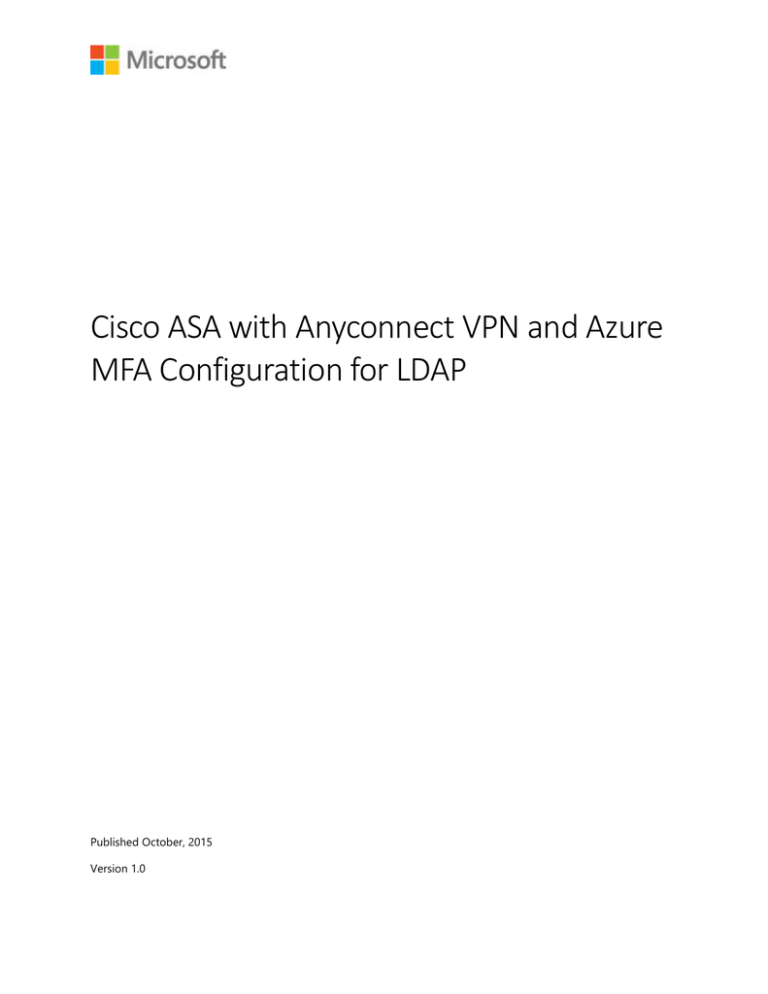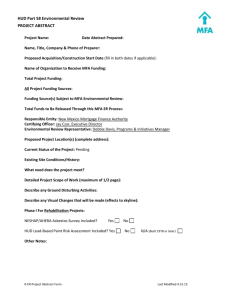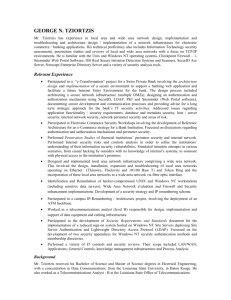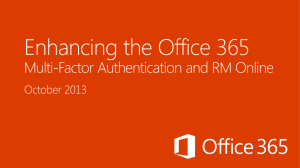Cisco ASA with Anyconnect VPN and Azure MFA Configuration for
advertisement

Cisco ASA with Anyconnect VPN and Azure MFA Configuration for LDAP Published October, 2015 Version 1.0 Azure Multi-Factor Authentication seamlessly integrates with your Cisco® ASA VPN appliance to provide additional security for Cisco AnyConnect® VPN logins and portal access. Multi-factor authentication (MFA) is combined with standard user credentials to increase security for user identity verification. Azure supports several multi-factor authentication methods for Lightweight Directory Access Protocol (LDAP). Each method is a challenge-response mechanism that occurs after primary authentication with standard user credentials. Phone call – users receive a phone call with instructions on how to complete login. Text message – users receive an SMS message that contains a verification code. Azure supports two-way messaging for LDAP; users are required to send a verification code by text message reply. Mobile app – users receive a push notification from client software installed on a smart device, like a phone or tablet. The Azure Authenticator app is available for Windows Phone, iOS, and Android. This guide will help you to configure Azure Multi-Factor Authentication (MFA) server and Cisco ASA to use LDAP for AnyConnect VPN authentication. Overview The Azure Multi-Factor Authentication server acts as an LDAP server. The Cisco ASA appliance acts as an LDAP client. The LDAP server works as a proxy to forward requests that use multiple authentication factors to a target directory service. The proxy receives a response from the directory, which it sends to the LDAP client. Access is granted only when both the user credentials (primary authentication) and the MFA challenge succeed. See the diagram in Figure 1 for reference. 2 6 challenge 8 response MFA MFA 5 challenge 7 response 10 Authenti cation response 9 Response LDAP 1 Authenti cation request 2 Request SSL VPN server MFA server 3 Request Primary Factor MFA Challenge/Response Methods 4 Response Phone call Text message Push notification Active Directory or LDAP Figure 1 The diagram above represents the logical process flow for MFA. The user experience for MFA is fairly similar to traditional login. See Figure 2 for a description of the workflow. 123456 Primary authentication + Secondary authentication Some MFA options require the code to be entered through the login promtpt. Figure 2 3 Successful authentication Guide Usage The information in this guide explains the configuration common to most deployments. It is important to note two things: Every organization is different and may require additional or different configuration. Some configuration may have other methods to accomplish the same task than those described. Information is based on the conditions described in the Prerequisites and Components sections. The Conventions section provides usage information and details about the environment used for this guide. Prerequisites The following conditions are required to set up Azure MFA: An MFA server installed on a system with either: Windows Server 2003 or higher. Windows Vista or higher, that has Users Portal and Web Service SDK services installed. A Cisco ASA appliance with Adaptive Security Device Manager (ASDM) access and default AnyConnect client configuration to use for MFA. NOTE: Default configuration can be configured by running the AnyConnect VPN wizard from the ASDM console. Cisco AnyConnect client software installed on all clients that connect remotely to the network. Familiarity with the following technologies: LDAP configuration VPN appliance administration Deployments offering the mobile app authentication option will also require: MFA deployed on systems with Windows Vista or higher require the Mobile App Web service to be installed. A user device with the Azure authentication application installed. Components The following conditions reflect the assumptions and scope for information described in this guide. The Azure MFA server is installed on a domain-joined Windows 2012 R2 server. One Azure MFA server will be configured for LDAP. One Cisco ASA appliance is configured. Conventions Information is based on the following conditions. 4 The guide was written using a Cisco ASA 5506 appliance. Documentation will refer to the Cisco ASA appliance as the VPN appliance, or just appliance. The Azure Multi-Factor Authentication Server is referred to as the MFA server. Active Directory (AD) is the directory service used for authentication. An SSL certificate will be used to encrypt authentication. Users will be imported from AD. A default token method will be configured. The OATH token method uses verification codes generated by the Azure Authentication app. NOTE: While Azure MFA includes the option use Personal Identification Numbers (PINs) as an additional factor to the supported authentication methods, that configuration is outside the scope of this guide. Step 1: Configure Multi-Factor Authentication Server This topic explains how to configure the MFA server and the on-premises resources it requires. First you will log in to the server where MFA is installed. Next you will configure LDAP Authentication. Then you will connect MFA to the directory service, after which you will configure a default authentication method. Finally you will import accounts to the MFA Users group. Multi-Factor Authentication Server Console 1. Log in to the server where MFA is installed. 2. Open the Apps screen. 3. Click the Multi-Factor Authentication Server icon: 4. The Multi-Factor Authentication Server window opens. Now you will configure the necessary services. LDAP Authentication First you will enable LDAP authentication, and then add the VPN appliance as a client. 5 1. Click the LDAP Authentication icon. 2. When the LDAP Authentication tool opens, select Enable LDAP Authentication. 3. Select the Clients tab if necessary. 6 NOTE: Keep track of the port numbers noted for authentication as you will need them for the VPN appliance configuration. Default is 636 when using SSL encryption. Unencrypted authentication is outside the scope for this guide. 4. If you are using secure LDAP, click Browse to import the SSL certificate. 5. Click Add to open the Add LDAP Client dialog box. 7 6. Complete the following: a. IP address – enter the VPN appliance address. b. Application name – enter a descriptive name for the VPN appliance. c. Require Multi-Factor Authentication user match – select; only users who are included in the MFA Users list will be granted access. NOTE: This feature provides better control over remote access. If not enabled (unchecked), then only users who are included in the MFA Users list will need to authenticate with MFA. Other domain users will be able to authenticate without MFA. 7. Select the Target tab. 8. Confirm the Target field displays LDAP. You have completed configuring LDAP authentication and adding the VPN appliance as an LDAP client. Leave the Multi-Factor Authentication Server window open for the next task. Directory Integration Now you will connect to the directory service. 8 1. In the navigation area, click the Directory Integration icon. 2. When the Directory Integration tool opens, select the Settings tab if necessary. 3. Select Use Specific LDAP configuration. 9 4. Click Edit to open the Edit LDAP Configuration dialog box. 5. Complete the following: a. Server – enter the directory server host name or IP address. NOTE: An FQDN is required if the Bind type below is set to SSL. b. Base DN – enter the directory path. c. Bind type – select the protocol to use for directory searches and authentication. NOTE: assigning the correct bind type is essential for security. I. Queries – search options are: Anonymous Simple SSL Windows II. Authentication – authentication options are: Anonymous 10 Simple SSL Windows d. Bind DN – only required for the SSL Bind type; enter a domain\user account with administrator privileges. e. Bind Password – only required for the SSL Bind type; enter the password for the account. f. Query size limit –specify the maximum number of users a search will return. 6. Test – click to confirm that the MFA server is able to successfully connect to the LDAP server. 7. Once the test completes successfully, click OK. 8. Click OK to close the completion prompt. You have completed the MFA server directory service setup. Leave the Multi-Factor Authentication Server window open for the next task. Default Authentication Method The instructions below explain how to set a default option for the authentication method that will be automatically assigned to MFA user accounts. A default method is required when user are not allowed to change methods. The feature is optional when users are allowed to change their token methods, and may be more convenient if a majority of users need one method. Configure Company Settings 1. In the navigation area, click the Company Settings icon: 11 2. When the Company Settings tool opens, select the General tab if necessary. 3. Leave default settings except for the following: User defaults – select one of the options below: Phone call – select Standard from the drop menu: 12 13 Text message – select Two-Way and OTP from the drop menus: Mobile app – select Standard from the drop menu: Note: This option will require users to register their devices through the Azure authentication app. This completes the company information setup to designate the default authentication method for LDAP Authentication. Leave the Multi-Factor Authentication Server window open for the next task. MFA Users When the VPN appliance was configured as an LDAP client, access was restricted to members of the MFA Users group. This provides more control over remote access, and is a security best practice. Now accounts need to be imported from the directory service. Then, the MFA administrator account needs to be configured so that LDAP requests do not require MFA. Import User Accounts Theses instructions are for on-demand user import. 1. In the navigation area, click the Users icon. 14 2. When the Users tool opens, Click Import from LDAP. 3. On the import screen, select a user group. 15 4. Select the user accounts you want to import. 5. Leave the default settings except for the following: a. Select the Settings tab if necessary. 16 b. In the Import Phone drop menu, select Mobile. NOTE: For purposes of this guide we are designating the Mobile attribute for the phone import setting. It is the most common option used for MFA. 6. Click the Import button. 17 7. Click OK in the import success dialog box. 8. Click the Close button on the import screen to return to the Users pane. Leave the Users tool open for the next task. Administrator Account The following instructions explain how to configure the MFA administrator account to facilitate LDAP requests without needing to negotiate multi-factor authentication requests. This provides the best balance between security and functionality when the administrator account is used for LDAP requests. 1. Select the Administrator account. 2. Click Edit. 18 3. Select the General tab if necessary. 19 4. Clear the Enabled checkbox. 5. Select the Advanced tab. 20 6. Leave the default settings, except for the following: a. When user is disabled – select Succeed Authentication. b. Account is used for LDAP Authentication password changes – select to allow end users to change their own passwords. 21 7. Click Apply. 8. Click Close. You have completed MFA server configuration. Step 2: Configure the VPN Appliance Now that the authentication process has been configured to use multiple factors, you need to configure the VPN appliance to connect to the LDAP server. ASDM Console Configure an authentication server on the VPN appliance that will send LDAP authentication requests to the Azure MFA server. First you will configure a server group for the MFA LDAP server. Next you need a connection profile for AnyConnect to access the LDAP server. Then you will create a profile to set a custom timeout value to ensure that AnyConnect VPN clients have enough time to log in using MFA. 22 Create AAA Server Group 1. Log in to the Cisco ASDM console for the VPN appliance. 2. Navigate to Configuration|Remote Access VPN|AAA/Local users|AAA server groups. 23 3. Click Add to create a new group. 24 4. The Add a new AAA Server Group dialog opens. 5. Leave the default settings except for the following: a. AAA Server Group – specify a name to identify the group for the MFA server. b. Protocol – select LDAP. c. Click OK. 6. In the AAA Server Groups list, select the server group you just created. 25 7. In the Servers in the Selected Group pane, click Add. 26 8. The Add AAA Server dialog opens. 27 9. Leave the default settings except for the following: a. Interface Name – select the interface that will handle communication with the MFA Server. b. Server Name or IP Address – specify the name or the IP address of the MFA server. c. Timeout (seconds) – it is important to set a sufficient length of time for users to authenticate. 60 seconds is a common duration, but may need to be adjusted. For example, large organizations may need more time to accommodate a higher volume of requests. d. Server port – enter the port number used for authentication communication on the MFA Server. Default is 636 when using SSL encryption. e. Server Type – select the LDAP server type. In this example we are using Active Directory, and will select Microsoft. f. Base DN – specify where the authentication server should begin searching for user entries. g. Scope – specify the extent of the search in the LDAP hierarchy that the server should query. h. Naming Attribute – enter unique naming attribute that identifies an entry on the target LDAP server. For example, sAMAccountName or userPrincipalName. i. Login DN – enter a domain administrator account DN that has rights to search or lookup users in the target LDAP server. j. Login Password – enter the administrator password. k. LDAP Attribute Map – leave this set to the default, unless your directory has customized attributes. 28 l. LDAP Parameters for group search – specify whether a group should be extracted from the LDAP server. NOTE: If there are a large number of groups to query, the timeout setting may require a higher value. m. Click OK. 10. Click APPLY to save the configuration. Test Configuration You can test the connection to MFA server to confirm that the connection is correctly configured. 1. Make sure the LDAP server you created is still selected. 2. Click the Test button to open the test tool. 29 3. Select a test option: 4. Enter credentials for an account that is configured for Azure MFA. 5. Click OK and wait for test results to post. Enable Connection Profile 1. Navigate Remote Access VPN|Network (Client) Access|AnyConnect Connection Profiles. 30 2. Leave default settings, except for the following: a. Enable Cisco AnyConnect VPN Client access on the interfaces selected in table below – confirm checkbox is selected. 31 b. Select the appropriate SSL interface access option. c. Connection Profiles – select the AnyConnect VPN profile. 32 d. Click Edit. e. The Edit AnyConnect Connection Profile window opens. 33 f. 34 Navigate to Authentication|Method. g. Confirm the following: i. Method – make sure AAA is selected. ii. AAA Server Group – make sure the group created for the MFA server is selected. h. Click OK. i. Click Apply to save the configuration. 35 Configure Timeout 1. Navigate to Remote Access VPN|Network (Client) Access|AnyConnect Client Profile. 36 2. Click Add. 37 3. The Add AnyConnect Client Profile dialog opens. 4. Leave the default settings, except for the following: a. Profile Name – enter a descriptive name for the new VPN profile. b. Click OK. 5. Select the VPN Profile that was created and click Edit. 6. The AnyConnect Client Profile Editor opens. 38 7. Leave default settings except for the following: a. Click Preferences (Part 2). 39 b. Navigate to Authentication Timeout (seconds). 40 c. Change the value to 60 seconds. Large organizations may require a longer duration. d. Click Server List. 41 42 e. Click Add. f. Add the Cisco ASA Host Display Name and the FQDN/IP Address to the profile. g. Click OK. h. Click OK to save configuration changes to the VPN profile. 8. Click Apply to save the configuration. 43 IMPORTANT: The AnyConnect Client Profile you just created must be installed on every device that will use MFA authentication to avoid timeout issues during the login process. One way to accomplish this would be to require clients to connect to the AnyConnect portal and then push the profile automatically. You have completed VPN appliance setup. Step 3: Test Authentication The topics below are provided to help test authentication with the setup you just completed. Login instructions are provided for each of the authentication methods. Device registration instructions are included for deployments that use the mobile app authentication method; if you aren’t going to use mobile app, then skip straight to the Login section. Device Registration for Azure Authenticator Users This step only applies when the mobile app authentication method is used. The following instructions explain how to activate a user device through the MFA server Users Portal. Please note the following requirements prior to getting started. 44 Requirements A device with the Azure Authenticator mobile application installed. The application can be downloaded from the platform store for the following devices: Windows Phone Android iOS The Azure Users Portal address. A computer to access the Users Portal. User credentials Activate Device NOTE: Information provided below is current as of the publication date, but is subject to change without notice. 1. Log in to the Azure user portal from a computer. 2. The setup screen displays. 3. Click Generate Activation Code. 4. Activation code options will display. 45 5. Open the mobile authentication app on the user device. Example: 6. There are two options: Enter the Activation Code and URL displayed on the Users Portal screen on the device activation screen. Use the device to scan the barcode displayed on Users Portal screen. 46 You have completed device activation. Login Now you are ready to test MFA authentication. Please note the requirements listed below before you start. General Requirements The Cisco AnyConnect VPN Client Profile installed on the device that will access the network The IP address or hostname for AnyConnect VPN access User credentials Phone Call Required: A phone with the number listed in the AD user account Mobile phone attribute. 1. On a computer, launch the AnyConnect client and connect to the network. Example: 2. Enter user credentials. 3. Check the phone for a call. NOTE: The call originates in the cloud from the Azure MFA application. Example: 47 4. The phone call will provide instructions to complete authentication. Text Message Required: An SMS-capable phone with the number listed in the user account Mobile phone attribute 1. On a computer, launch the AnyConnect client and connect to the network. Example: 2. Enter user credentials. 3. Check the phone for a text message with the verification code. Example: 48 4. Reply to the text message with the same verification code. Mobile App Required: A device with the Azure Authenticator app activated. 1. On a computer, launch the AnyConnect client and connect to the network. Example: 2. Enter user credentials. 3. Check the device with Azure Authenticator for a prompt. Example 49 4. Click Verify. 5. The authentication application will communicate with the MFA server to complete authentication. Successful authentication for the VPN connection is indicated by the client. Example: 50 This completes the setup and testing for Azure Multi-Factor Authentication using the LDAP protocol in a Cisco ASA/AnyConnect VPN appliance deployment. 51







